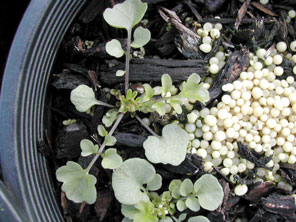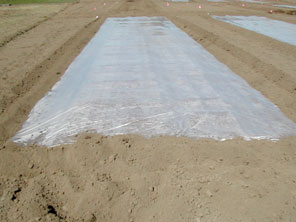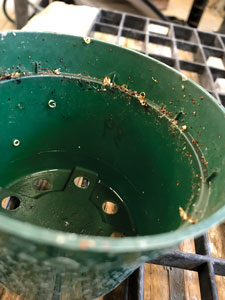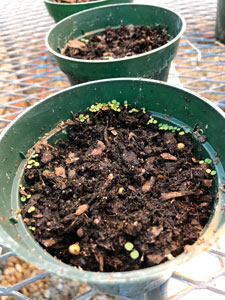10/1/2017
Hot & Steamy
Dr. James Altland
Weed control in propagation is difficult. Pre-emergence herbicides are one of the primary tools for weed management in container crops. However, these products are neither labeled nor safe for use in most greenhouses or covered propagation areas. Reuse of plastic propagation trays and containers exacerbates the weed problem. Seeds of many weeds, most notably bittercress (
Cardamine flexuosa) and creeping woodsorrel (
Oxalis corniculata), stick to plastic containers and trays and are reintroduced into the production system when they’re reused (Figure 1).
 Figure 1. Bittercress is the most common weed in container crops throughout the U.S.
Figure 1. Bittercress is the most common weed in container crops throughout the U.S.
A common scenario plays out in many nurseries. Weeds begin growing in propagation pots, with most of them germinating near the edge of the pot from seed attached to reused plastic. These weeds are then hand-pulled, at great expense, so that the propagation liners appear clean at the time of potting. But this is rarely true. Containers or pots with weeds are very difficult to hand-weed thoroughly enough to completely remove the whole plant.
These seemingly weed-free liners are then shifted up into larger containers. A few days or weeks later, weeds start growing from around the liner, spreading outwards to eventually cover the entire substrate surface. It’s commonly thought that the tendency for weeds to grow near the potted liner is due to poor herbicide coverage around the plant (as the plant can deflect the herbicide). However, I believe poor weed control in the center of the pot is because the liner itself is a primary source of weeds.
But if we start at the beginning, and look at the system as a whole, it’s clear that the weed problem really starts in reusing old and dirty propagation pots. This is not a new discovery. Research 20 years ago at Clemson University found that simply pressure washing reused containers between crops reduced weed numbers in propagation six-fold.
Some nurseries are using hot water or steam for sterilizing reused containers and propagation trays. Initially, nurseries adopted this technology as a means for eliminating disease pathogens. However, these nurseries have also reported vast improvements in weed control.
Sterilizing containers and propagation trays with steam or hot water appears to be used regionally throughout the U.S. We conducted an informal survey of U.S. nurseries by asking university extension specialists about the use of this technology in their states. It’s been adopted, at least by a few large nurseries, in Oregon, Ohio, Washington and Virginia. However, it was reported as not being used in many other large nursery-producing states.
There may be several reasons this technology has only been implemented regionally. In Oregon, some nurseries have adopted the Grower Assisted Inspection Program (GAIP) to prevent the spread of Phytophthora ramorum. Part of this program includes the use of hot water for killing P. ramorum on reused plastic by dipping it in a water tank at 176F (80C) for 15 minutes. While this control point was intended to prevent the spread of P. ramorum, it’s also very effective in reducing bittercress populations.
 Figure 2. Soil solarization requires days or weeks to build up enough heat to kill weed seed.
Figure 2. Soil solarization requires days or weeks to build up enough heat to kill weed seed.
Other nursery operations we surveyed are using hot water or steam at temperatures ranging from 140 to 194F (60 to 90C), with exposure times from 15 minutes to four hours. While these operations are unanimously enthused about the level of weed control provided by this form of sterilization, the temperature and exposure times selected were essentially “best guesses.”
So what temperatures are needed for killing seeds of common container weeds? Heat from steam or hot water will kill weed seeds. There’s an abundance of research on the use of soil solarization to reduce weed seed populations and other pests in soil. Soil solarization, however, is a slow process that involves covering the ground with clear plastic to heat soil over several days or weeks (Figure 2). Research on soil solarization has established thermal killing temperatures over the range of 104 to 158F (40 to 70C) with exposure times of hours to days. While that’s intriguing, we’re more interested in a steam or hot water application that could kill weed seeds in a matter of minutes.
There’s no published (or otherwise) information on how high the temperature or how long the exposure time must be to provide 100% seed death when dipping or washing plastic pots. The most cited publication is over 60 years old (“The U.C. System for Producing Healthy Container-Grown Plants” by K. Baker, 1957) and suggests that “most weed seeds” are killed with temperatures at 158 to 176F (70 to 80C) when exposed for 30 minutes. However, the same authors indicate that a few resistant weed seeds require 194 to 212F (90 to 100C).
The Washington Department of Natural Resources Webster Nursery uses a hot water dip tank to clean Styrofoam propagation blocks. The blocks are dipped in 170 to 179F (77 to 82C) water for one minute. This hot-water dip is part of an overall disease and weed sanitation program. However, the primary species of interest are liverwort (Marchantia polymorpha) and mosses with unprotected spores that are much easier to kill than weed seeds protected by a hardened seed coat.
So what temperatures are needed for killing weed seeds of container crops? With that information lacking, we initiated our own studies to determine the temperature and exposure time for killing container weed seed.
The experiment
Ten bittercress seeds each were placed into 80 glass test tubes. The test tubes were placed into a digitally programmable hot water bath set at either 140, 167 or 194F (60, 75 or 90C). Within each temperature setting, groups of five test tubes were placed in the hot water bath for one, five, 10, 30 or 60 minutes. There were also a group of five control test tubes that were not heated and remained at room temperature.
After the heat treatment, seed from each tube were transferred to a Petri dish containing an agar base. Petri dishes were placed in a growth chamber programmed with a 12-hour photoperiod with 72F (22C) day and 64F (17C) night temperatures. After two weeks, weed germination in each Petri dish was tabulated to determine the effective killing temperature and exposure time.
Bittercress were not controlled with 140F (60C) water, regardless of exposure time (Table 1). Germination was reduced with 167F (75C) water and germination decreased with increasing exposure time at that temperature. Only a single bittercress seed in just one of the five Petri dishes germinated when treated with 194F (90C) water. For rapid exposure times of five minutes or less, high temperatures of at least 194F (90C) will be needed for effective control of bittercress. Lower temperatures of 167 to 185F (75 to 85C) might be effective with sufficiently long exposure time.
Hot-water validation
We conducted a second experiment to see how effective these temperatures would be in treating actual plastic containers that were stacked and potentially insulating each other. Four-inch containers were filled with commercial potting mix and placed in our research nursery with overhead irrigation. Containers were overseeded with bittercress and allowed to grow until plants were actively dispersing new seed (approximately five weeks).
At that time, containers were emptied of media and the number of bittercress seed sticking to the container wall were recorded. Containers were then stacked into groups of five. Four groups of containers (stacked five high) were submerged in a water bath at 185 or 203F (85 or 95C) and left there for either 10 or 60 minutes. After being submerged for the allotted time, containers were separated and the number of attached seed were counted again (to determine how much seed is simply washed off during submersion). Containers were then filled with additional substrate and placed back into the nursery with overhead irrigation. The number of bittercress to germinate around the edge of the pots were counted after two weeks (Figures 3 and 4).
 Figure 3. Bittercress seed stick to plastic remarkably well, with most seed remaining in place even after stacking and dipping in water.
Figure 3. Bittercress seed stick to plastic remarkably well, with most seed remaining in place even after stacking and dipping in water.
There were about 60 seeds attached to each container immediately after removing them from the seed dispersal phase at the nursery. After stacking the containers and dipping them in hot water, there were about 48 seeds per container remaining. The stacking and dipping process physically removed about 30% of the seed. After filling the containers with additional potting mix and returning them to the nursery, seed in the control pots germinated within the first week. After two weeks, there were on average 40 bittercress seedlings in each of the control pots. Over 80% of the seed attached to the control pots germinated! The good news, however, is that none of the seed on the containers dipped in hot water germinated. At 185 or 203F (85 or 95C), regardless of exposure time, all bittercress seed were killed.
Cost and other considerations
The cost of using hot water or steam should not be a deterrent. One nursery reported using propane to generate steam for heating a converted trailer. The trailer is heated to 190F (88C) over a period of four hours. This consumes 20 to 25 gal. of propane ($0.71/gal.) and costs a total of $17.00. Compared to the labor costs for hand-weeding propagation liners, and the legacy effect those weeds in propagation will have on continued weed problems throughout the production life of that crop, the fuel costs for generating steam are negligible.
 Figure 4. Bittercress germinate near the edge from seed attached to the pot wall. A similar scenario occurs in many nursery propagation areas.
Figure 4. Bittercress germinate near the edge from seed attached to the pot wall. A similar scenario occurs in many nursery propagation areas.
Not all plastic is created equal. Some containers and trays are more heat-resistant than others, so this will need to be considered with any hot water or steam application. One nursery uses steam to treat their more durable pots and hot water to treat less-durable trays and liners.
There are very few options beyond hand-weeding for controlling weeds in propagation. The use of steam or hot water to sterilize trays and containers has the potential to dramatically reduce weed pressure and the costs in this sensitive phase of production.
GT
Dr. James Altland is a Research Horticulturist with the USDA-ARS in Wooster, Ohio. He can be reached by email at james.altland@ars.usda.gov. Mention of any commercial product in this article is for educational purposes only and should not be considered an endorsement by USDA-ARS.